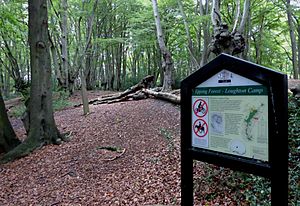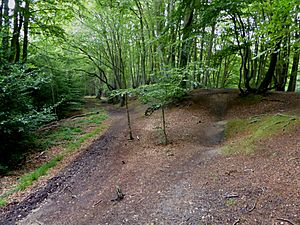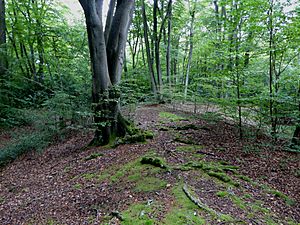Loughton Camp facts for kids
Loughton Camp is an ancient Hill fort located in Epping Forest, about 1.6 kilometers (1 mile) northwest of the town of Loughton. It was built during the Iron Age, around 500 BC. This means it is over 2,500 years old!
A hill fort is a type of fort built on a hill. People in the Iron Age used these forts for protection. They often had large banks and ditches around them to keep enemies out.
Contents
What is Loughton Camp?
Loughton Camp is a special place with old earthworks. These are like big bumps and hollows in the ground. They show where the camp's walls and ditches used to be. The camp covers an area of about 4 hectares (10 acres).
Today, you can see a low bank and a ditch that go all the way around the camp. Long ago, the bank was probably a very tall wall, called a rampart. This rampart helped defend the people inside. The ditch was likely very wide and deep too.
Why Was it Built Here?
Loughton Camp is on one of the highest spots nearby. This high ground was likely very important for defense. People think the camp was used by a tribe called the Trinovantes. They might have used it to protect themselves from another tribe, the Catuvellauni.
Being so high up, the camp could have been a lookout post. From here, people could see far away and spot any danger coming. It might also have been a safe place to keep cattle. An old stone millstone, used for grinding grain, was found nearby. This shows people lived and worked here.
Local Legends and History
There's a fun local story that Boudica, a famous Celtic queen, used this camp. Some even say that Ambresbury Banks, another nearby camp, was where she was defeated in AD 61. However, there is no real proof for these exciting stories.
The southwestern part of the camp slopes down steeply. This area is known as Kate's Cellar. It's named after a hermit who supposedly lived there a long time ago. An old map from the 1800s even shows it as a hideout for Dick Turpin, a famous highwayman! Epping Forest has many places that claim to be his hideout.
Discovering the Past
Loughton Camp was "discovered" in 1872 by a man named Benjamin Harris Cowper. The first archaeological dig happened in 1881. This work was led by General Pitt-Rivers, who was a very important archaeologist.
In 1882, a group called the Essex Field Club did more digging. They explored the old banks of the camp. These digs help us learn more about how people lived long ago.
Some historians, like Roger Nolan, believe Loughton Camp was a marching camp used by Julius Caesar. This would have been during his invasion of Britain in 54 BC. He thinks Caesar's army stayed here on their way to Wheathampstead. More digging would be needed to find out if this is true.
Other Nearby Camps
There is another similar camp called Ambresbury Banks. It is closer to the town of Epping. Both Loughton Camp and Ambresbury Banks are protected as Scheduled Ancient Earthworks. This means they are very important historical sites. You can explore them, but only by walking.
Images for kids








